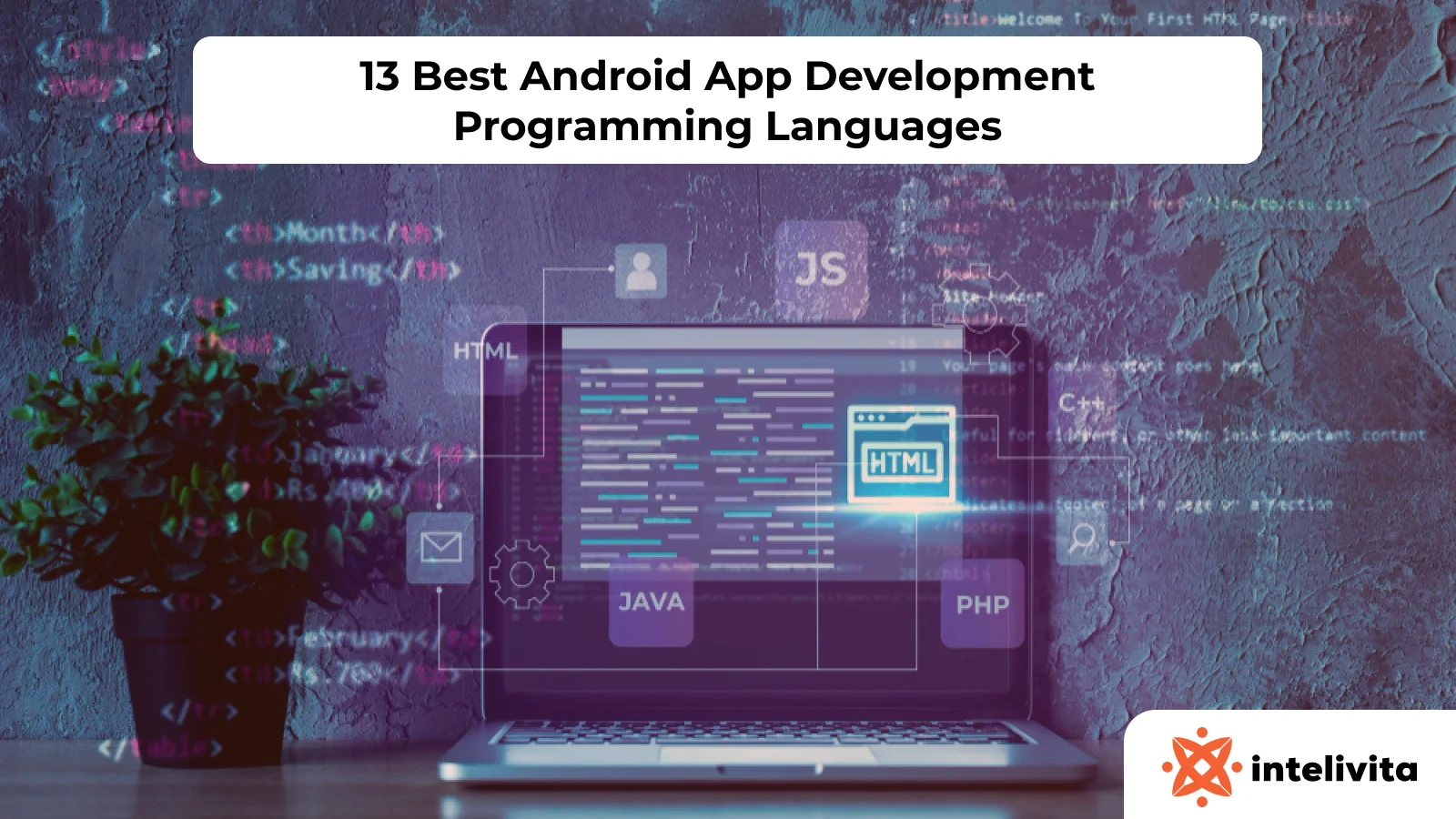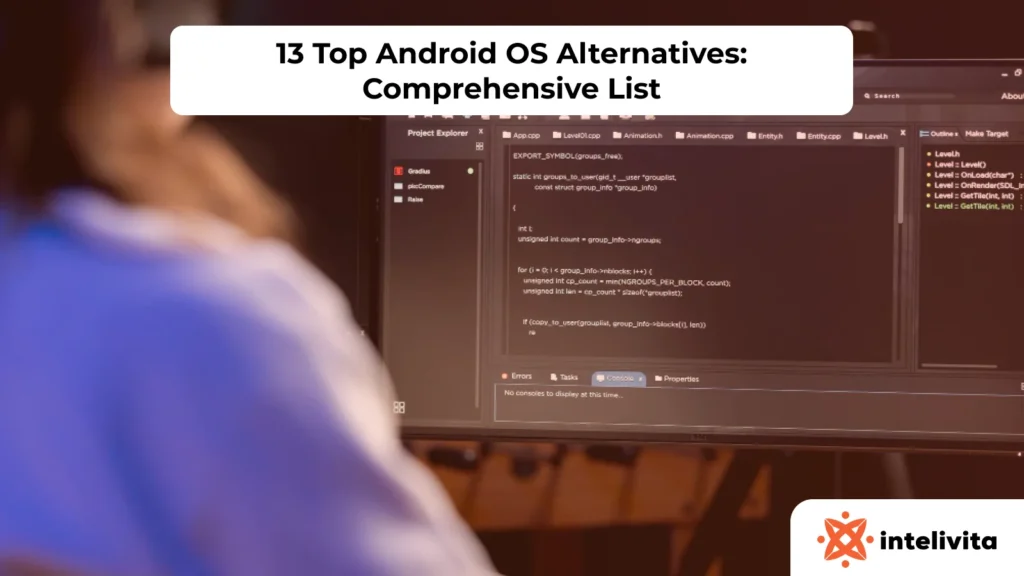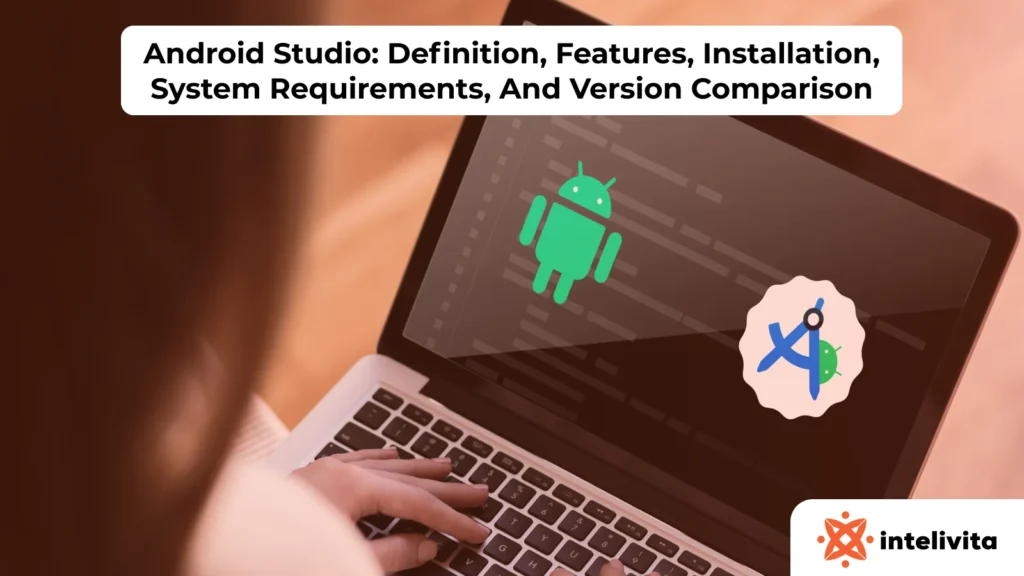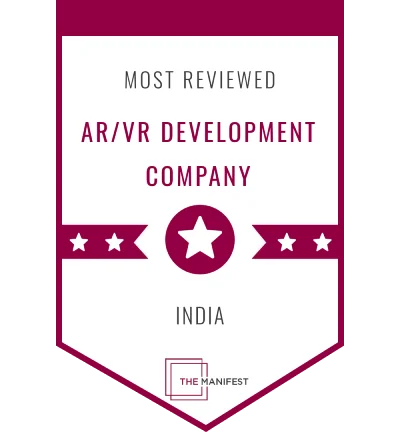Popular programming languages for Android app development include Java, Kotlin, Dart, and C++. Java is robust and widely used in enterprise-level apps. Kotlin, with modern syntax and null safety, is now the preferred choice for most Android development. Dart integrates with Flutter, making it ideal for cross-platform UI. C++ is chosen for performance-intensive applications such as gaming and real-time systems.
Programming Languages Used in Android App Development are:
- Java
- Kotlin
- Dart
- C++
- C#
- JavaScript
- Python
- React Native
- Swift
- Xamarin
- HTML and CSS
- Corona
- Flutter
Android app development involves building mobile applications using tools like Kotlin, Java, and Flutter that are optimized for performance on Android devices. The app development process includes writing code, designing user interfaces, testing functionality, and deploying the final product.
According to a comprehensive study published by the Android Authority in their “2024 Developer Survey Report,” Kotlin is now the most widely adopted language for Android app development, with 58% of developers identifying it as their primary choice.
Java
Java has been a central language for Android development since the platform’s launch due to its compatibility with the Android SDK and broad support from Google. Java applications run on the Java Virtual Machine (JVM), which enables platform independence. Developers use frameworks such as Spring and Hibernate to accelerate backend integration and improve functionality.
Java is best suited for creating robust, complex Android applications that require extensive backend integration, advanced data handling, or support for legacy codebases. Java has been used in Android development for decades. Java offers extensive documentation and active developer forums. Java provides development tools such as Android Studio and Gradle to streamline app creation.
Pros of Java
- Platform independence via the JVM.
- Extensive documentation and a large developer community.
- Rich ecosystem of libraries and tools.
- Object-oriented programming supports scalable and maintainable code.
Cons of Java
- Verbose syntax compared to modern languages like Kotlin.
- Higher potential for boilerplate code, which slows down the development of smaller apps.
- Less expressive language constructs make some tasks more cumbersome.
Kotlin
Kotlin is a modern, statically typed programming language designed to work well with Java. It has become the preferred choice for Android app development. Officially supported by Google since 2017, Kotlin simplifies code structure, reduces boilerplate, and offers enhanced null safety features, which prevent common programming errors. Its concise syntax and interoperability with Java have made it a favorite among both new and experienced developers.
Kotlin supports modern Android app development with concise syntax, null safety, and seamless Java interoperability. Kotlin reduces boilerplate code and prevents null pointer errors. Kotlin integrates with existing Java codebases without compatibility issues. Kotlin improves developer productivity by reducing boilerplate code. Kotlin supports scalability with features such as coroutines and extension functions. The language’s readability and expressive features lead to cleaner code, making development faster and less error-prone.
Pros of Kotlin
- Concise and expressive syntax reduces boilerplate code.
- Built-in null safety prevents many common runtime errors.
- Fully interoperable with Java, making it easy to adopt in existing projects.
- Modern language features, such as extension functions and coroutines, streamline asynchronous programming.
Cons of Kotlin
- Slower compilation times compared to Java in certain scenarios.
- Smaller community and fewer third-party libraries compared to Java.
- Newer language, so less mature tooling and fewer long-term use cases.
Dart
Google developed Dart for powering the Flutter framework. Flutter enables cross-platform mobile development from a single codebase. Dart offers fast compilation and a simple syntax. Dart offers fast compilation. Dart provides a simple syntax. Dart enables developers to write a single codebase for Android, iOS, and web. A single Dart codebase reduces duplication and accelerates development.
Dart is best suited for developers looking to build visually appealing, high-performance mobile applications that work seamlessly on both Android and iOS. Its compatibility with Flutter gives it a unique advantage. Flutter provides a rich set of pre-designed widgets and tools for building responsive user interfaces. Flutter includes built-in widgets such as Material and Cupertino. These widgets help developers design consistent UIs for Android and iOS.
Pros of Dart
- Excellent cross-platform support, enabling a single codebase for Android, iOS, and web apps.
- Fast development cycles due to JIT compilation and hot reload.
- Comprehensive set of built-in widgets for creating visually consistent user interfaces.
- Strong performance on Android devices due to AOT compilation.
Cons of Dart
- Smaller community compared to Java or Kotlin.
- Fewer native libraries and integrations outside of Flutter.
- Requires learning a new framework (Flutter) for full utilization.
C++
C++ is used in Android development for tasks that require high computational efficiency, such as graphics processing and hardware-level access. C++ is not a primary language for most Android projects. C++ is employed via the Android Native Development Kit (NDK) to handle CPU-intensive operations, graphics, and hardware-level programming.
C++ is best suited for developers working on high-performance gaming applications, real-time simulations, or processing-intensive tasks that demand optimal performance. Its integration with Android’s NDK allows for leveraging native code, enabling the creation of resource-efficient applications. C++ is well-suited for applications such as 3D games, media processing, and embedded systems where low-level access is required.
Pros of C++
- High-performance execution for resource-intensive tasks.
- Access to low-level system resources and hardware features.
- Broad compatibility with existing C++ libraries and tools.
- Suitable for cross-platform development when combined with appropriate frameworks.
Cons of C++
- Steeper learning curve, especially for developers accustomed to managed languages.
- Increased development complexity due to manual memory management.
- Limited use in standard Android development compared to Java or Kotlin.
- Slower iteration cycles due to a lack of native hot-reload capabilities.
C#
C# is an object-oriented programming language. Microsoft developed C# for modern application development. C# is used in Android development through the Xamarin framework. C# enables developers to write clean, maintainable code. C# uses strong type checking and garbage collection to reduce common runtime errors. C# provides built-in support for asynchronous programming, which simplifies tasks such as network requests and background processing.
C# is best suited for developers who want to create cross-platform mobile applications. Xamarin enables a single codebase to run across Android, iOS, and Windows devices. This approach ensures consistent functionality and interface design on multiple platforms, which makes Xamarin suitable for cross-platform projects.
Pros of C#
- Cross-platform development with Xamarin, reducing duplication of code.
- Simplified asynchronous programming with async and await keywords.
- Strong integration with Microsoft tools and services, such as Visual Studio.
- Readable, maintainable syntax that reduces development time.
Cons of C#
- Dependence on Xamarin results in larger app sizes and slightly lower performance.
- Licensing costs are associated with some Microsoft tools and services.
- Smaller Android developer community compared to Java or Kotlin.
- Limited native Android integrations compared to languages like Java.
JavaScript
JavaScript is primarily used for web development. JavaScript is adapted for mobile applications through frameworks such as React Native, enabling cross-platform development. With the rise of frameworks like React Native and Ionic, it has become a viable option for creating Android apps. Cross-platform frameworks such as React Native and Ionic enable developers to use a single JavaScript codebase. A single codebase creates applications for Android, iOS, and the web.
JavaScript is best suited for developers looking to build cross-platform applications with shared codebases and web-like user interfaces. It is especially useful for teams that already have experience in web development, allowing them to transition to mobile app development without learning a completely new language.
Pros of JavaScript
- Extensive ecosystem with numerous libraries and frameworks.
- Cross-platform compatibility through frameworks like React Native.
- Familiarity for web developers reduces the learning curve.
- Fast development cycles due to hot-reload capabilities.
Cons of JavaScript
- Performance does not match that of native Android development languages.
- Limited access to certain platform-specific features without using additional plugins.
- Potentially larger app sizes due to the inclusion of frameworks and dependencies.
- Reliance on third-party frameworks introduces additional complexity.
Python
Python is a high-level programming language. Python is characterized by simplicity, readability, and versatility. Python is not a native language for Android development, but developers use tools such as Kivy and BeeWare to build mobile applications. These frameworks enable Python code to run on multiple platforms, including Android.
Python is suitable for prototyping, educational applications, and computation-heavy projects. Python integrates well with advanced data processing and machine learning tasks. Its clear syntax and extensive documentation make Python accessible to both beginners and experienced developers.
Pros of Python
- Python’s readable syntax reduces development time by making code easier to write and debug.
- Python offers libraries like NumPy, Requests, and Pandas, which simplify tasks such as data handling, networking, and computation.
- Frameworks like Kivy allow Python apps to run on Android, iOS, Windows, and Linux from a single codebase.
- Python integrates well with tools like TensorFlow and scikit-learn, making it useful for AI-powered Android apps.
Cons of Python
- Python lacks native Android SDK support and depends on third-party tools like Kivy or BeeWare to build and deploy mobile apps.
- Python applications run slower than Java or Kotlin applications because they rely on interpreted code and bridging layers.
- Accessing Android features such as Bluetooth APIs or in-app billing requires custom Java code or wrapper libraries.
- Python’s mobile development community is smaller, leading to fewer Android-specific tutorials, libraries, and support forums.
React Native
React Native, developed by Meta (formerly Facebook), enables developers to create mobile apps using JavaScript, making it accessible to web development teams. With a shared JavaScript codebase, React Native apps can run on both Android and iOS, reducing development time and effort. React Native delivers near-native performance. It renders the user interface with platform-specific components. It communicates with device APIs through a JavaScript bridge.
React Native enables teams to build applications for both Android and iOS. It ensures a consistent user interface across platforms and reduces development time. It suits teams with JavaScript experience who want to build mobile apps without learning a new language or rewriting existing logic.
Pros of React Native
- React Native provides a single codebase for Android and iOS platforms.
- Hot-reload shortens development cycles by enabling real-time code updates.
- React Native provides access to a large ecosystem of JavaScript libraries and community support
- React Native delivers near-native performance for most user interface elements.
Cons of React Native
- React Native requires native code for complex features, which increases project complexity.
- React Native delivers slightly lower performance compared to fully native apps.
- React Native depends on third-party plugins to implement certain platform-specific functionalities.
- React Native updates frequently, requiring ongoing maintenance.
Swift
Swift is an open-source programming language developed by Apple to build native applications for iOS, macOS, watchOS, and tvOS platforms. Swift is not natively designed for Android, but developers use it in cross-platform frameworks that target multiple operating systems. Swift’s strong type system and safety features prevent runtime errors such as null pointer exceptions and memory leaks.
Developers who work on Apple platforms or use cross-platform frameworks that compile Swift to Android benefit from its concise syntax and strong performance. Swift supports performance-critical applications in finance, healthcare, and media, where reliability and maintainable code are essential.
Pros of Swift
- Swift uses modern syntax and strong type safety to reduce errors and improve code readability.
- Swift delivers high performance comparable to native languages like C++ or Objective-C.
- Swift benefits from Apple’s ecosystem, which provides robust documentation, SDKs, and development tools.
- Swift’s growing adoption and active community improve resource availability and developer support.
Cons of Swift
- Swift does not natively support Android and requires cross-platform frameworks or tools.
- Swift has a smaller Android development community compared to Java or Kotlin.
- Swift offers fewer third-party libraries and integrations for Android-specific projects.
- Swift presents a learning curve for developers unfamiliar with Apple’s ecosystem.
Xamarin
Xamarin is a .NET-based framework that lets developers create Android apps using C#. It integrates with the .NET ecosystem, allowing developers to build native UIs and access Android features like camera and GPS. Xamarin lets developers reuse business logic across Android and iOS, speeding up development while delivering performance close to native apps.
Xamarin is a .NET-based framework that enables developers to build Android applications using C#. Xamarin integrates with the .NET ecosystem, allowing native UI development and access to Android features such as the camera, GPS, and device sensors. Xamarin supports code reuse across Android and iOS, which reduces duplication, accelerates development, and delivers performance close to native applications.
Pros of Xamarin
- Xamarin provides a single codebase that runs across Android, iOS, and other platforms, reducing duplication.
- Xamarin enables access to native Android APIs, which enhances application functionality.
- Xamarin delivers near-native performance through platform-specific optimizations.
- Xamarin integrates strongly with Microsoft tools, offering reliable support and ecosystem benefits.
Cons of Xamarin
- Xamarin applications have larger file sizes compared to fully native Android apps.
- Xamarin introduces a steeper learning curve for developers unfamiliar with the .NET ecosystem.
- Xamarin often adopts new Android features more slowly than Kotlin or Java.
- Xamarin relies heavily on Microsoft’s ecosystem, which reduces flexibility for certain projects.
HTML and CSS
HTML and CSS are applied in Android app development through frameworks such as Apache Cordova and Capacitor. These frameworks embed web applications inside a native container, where HTML defines the layout and CSS manages the design. This method allows web developers to reuse existing skills to build mobile apps without learning platform-specific languages.
HTML and CSS suit content-driven applications such as digital brochures, basic forms, and simple prototypes. They do not support demanding performance requirements or real-time functionality but remain effective for static layouts and straightforward navigation.
Pros of HTML and CSS
- HTML and CSS leverage widely known web development skills, lowering the entry barrier for developers.
- HTML and CSS enable rapid prototyping and support simple interface creation.
- HTML and CSS integrate with cross-platform frameworks such as Cordova and Capacitor.
- HTML and CSS present a minimal learning curve for developers with web backgrounds.
Cons of HTML and CSS
- HTML and CSS provide limited native functionality and reduced performance compared to Android’s native languages.
- HTML and CSS depend heavily on third-party plugins to access Android-specific features.
- HTML and CSS are unsuitable for resource-intensive or complex mobile applications.
- HTML and CSS deliver a user experience that feels less smooth than fully native Android apps.
Solar2D (formerly Corona)
Solar2D (formerly Corona) is an open-source framework for developing Android applications and 2D games with the Lua programming language. Solar2D enables developers to create 2D games and lightweight applications such as puzzles and quiz apps through its fast setup and optimized rendering engine. Solar2D provides a simple API and structured documentation, allowing new developers to start building games without extensive knowledge of Android internals.
Solar2D is suited for simple 2D games such as platformers and flashcard-based learning applications, as well as lightweight projects that do not require 3D graphics or hardware-level features. Solar2D emphasizes simplicity and speed, which makes it effective for rapid prototyping and launching small mobile games on Android.
Pros of Corona
- Solar2D uses the Lua programming language, which has a gentle learning curve for beginners.
- Solar2D supports fast development cycles through a straightforward API and real-time testing features.
- Solar2D is optimized for 2D graphics and lightweight applications.
- Solar2D is open-source and benefits from an active developer community.
Cons of Corona
- Solar2D provides limited support for complex native Android features.
- Solar2D is unsuitable for applications that require advanced 3D graphics or heavy backend integration.
- Solar2D has a smaller community and fewer libraries compared to mainstream Android languages.
- Solar2D depends on Lua, which is unfamiliar to many Android developers.
Flutter
Flutter is an open-source framework developed by Google for building cross-platform applications. Flutter allows developers to create Android, iOS, web, and desktop apps from a single Dart codebase, reducing duplication and streamlining development. Flutter uses the Dart language and provides built-in widgets such as Text, Container, and ListView to simplify UI creation. Flutter’s hot reload feature displays code changes in real time, which accelerates iteration and debugging.
Pros of Flutter
- Flutter provides a single codebase that runs on Android, iOS, web, and desktop platforms.
- Flutter includes a rich set of customizable widgets and a modern UI framework for consistent design.
- Flutter offers hot reload, which accelerates development and testing cycles.
- Flutter benefits from strong support by Google and an active, growing community.
Cons of Flutter
- Flutter requires learning Dart, which is unfamiliar to many developers.
- Flutter applications produce larger file sizes compared to fully native Android apps.
- Flutter has a less mature ecosystem than long-established platforms such as Java or Kotlin.
- Flutter can show performance differences when compared to purely native applications.
What is an Android App Development Language?
An Android app development language is used to write and compile apps specifically for the Android operating system, such as messaging or productivity tools. These languages integrate with the Android SDK and system APIs to access device features like camera, location, and storage.
Java, Kotlin, and C++ are widely used for native Android apps, while Dart (via Flutter) and C# (via Xamarin) support cross-platform development. According to JetBrains (2023), 80% of developers now use Kotlin, though Java continues to be used in older enterprise and banking applications.
What Is Android App Development?
Android app development is the process of building apps that run on devices powered by the Android operating system, such as games or productivity tools. Developers use tools like Android Studio, languages such as Kotlin or Java, and frameworks like Jetpack to design, code, test, and deploy apps with features like navigation, notifications, and data storage.
The Android application development process requires writing code in languages such as Java, Kotlin, or C++ within IDEs like Android Studio. The Android application development process uses the Android Software Development Kit (SDK) and supporting libraries to manage user interfaces, networking, data storage, and device-specific features.
What Programming Languages Are Used To Develop iOS Apps?
The programming languages used to develop iOS apps are Swift, Objective-C, C++, Python, and C#. Swift is Apple’s official language and is preferred for modern iOS projects because of its safety and performance features. Objective-C remains in use for maintaining legacy applications and older frameworks. C++ is applied where high-performance processing and graphics rendering are required. Python is used through bridging frameworks for prototyping, scripting, and machine learning tasks. C# supports Xamarin to build cross-platform solutions, making it part of the broader set of iOS app development languages that integrate with Apple’s ecosystem.
What Programming Languages Are Used For Cross-Platform App Development?
The programming languages used for cross-platform app development are Dart, JavaScript, TypeScript, C#, and Kotlin. Dart is the language of Flutter and supports a unified codebase for Android and iOS. JavaScript and TypeScript are used in frameworks such as React Native and Ionic to create cross-platform applications with type safety and scalable structures. C# powers Xamarin with .NET integration, enabling shared code and platform-specific customization. Kotlin is used in Kotlin Multiplatform to run common logic across Android and iOS while preserving native capabilities.
What Programming Language Does Android Studio Support?
Android Studio supports Java, Kotlin, and C++. Java is the foundation of Android development with strong libraries, platform independence, and community resources. Kotlin, officially supported since 2017, provides concise syntax, modern features, and null safety, making it Google’s preferred language. C++ is available through the Android NDK for tasks that require low-level control, advanced graphics, or real-time performance. Developers use Android Studio as the official IDE to write, test, and optimize these languages within the Android ecosystem.












